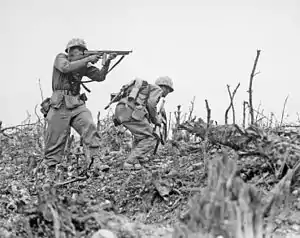Volcano and Ryukyu Islands campaign
The Volcano and Ryūkyū Islands Campaign was a series of battles and engagements between Allied forces and Imperial Japanese forces in the Pacific Ocean campaign of World War II between January and June 1945.
| Volcano and Ryukyu Islands Campaign | |||||||
|---|---|---|---|---|---|---|---|
| Part of the Pacific Theater of World War II | |||||||
 Two U.S. Marines advance from the 2nd Battalion, 1st Marines on Wana Ridge provides covering fire with his Thompson submachine gun, May 18, 1945. during the Battle of Okinawa. | |||||||
| |||||||
| Belligerents | |||||||
|
|
| ||||||
| Commanders and leaders | |||||||
|
|
| ||||||
| Casualties and losses | |||||||
|
19,321 killed in action, 7,700 missing, died of wounds or non-combat deaths, 74,501 wounded, 79 ships sunk and scrapped, 773 aircraft destroyed |
125,914 dead, 23,764 missing or presumed dead, 17,000 wounded, 7,455-10,755 captured, 21 ships sunk and scrapped, 3,130 aircraft destroyed, 75,000–140,000 civilians dead or missing | ||||||
The campaign took place in the Volcano and Ryukyu island groups. The two main land battles in the campaign were the Battle of Iwo Jima (February 16-March 26, 1945) and the Battle of Okinawa (April 1–June 21, 1945). One major naval battle occurred, called Operation Ten-Go (April 7, 1945) after the operational title given to it by the Japanese.
The campaign was part of the Allied Japan campaign intended to provide staging areas for an invasion of Japan as well as supporting aerial bombardment and a naval blockade of the Japanese mainland. The dropping of atomic weapons on two Japanese cities and the Soviet invasion of Japanese Manchuria, however, caused the Japanese government to surrender without an armed invasion being necessary.
The Campaign
Iwo Jima's strategic importance was debatable. The Allies considered the island to be an important staging area for future invasion forces, however, after the Allies captured Iwo Jima, their focus shifted from using the island as a staging area to employing the island as a base for fighter escorts and B-29 recovery. The Japanese had a radar station and airstrips to launch fighters that would pick off B-29s raiding the Japanese mainland. If captured by the Americans, it could provide them with bases for fighter escorts to assist the B-29 bombers in raiding the Japanese mainland, as well as being an emergency landing strip for any damaged B-29s that could not return to the Marianas.
The operation to take Iwo Jima was authorized in October 1944. On February 19, 1945, the campaign for Iwo Jima was launched. The island was secure by March 26. Only a few Japanese were captured, as the rest were killed or committed suicide as defeat befell them. However, the Americans suffered a heavy toll in casualties in their initial landing, as opposed to the main fighting. Fighters began operations from March 11, when the airfields were secured, and the first bombers hit the home islands.
Okinawa was right at Japan's doorstep, providing the springboard for the Allies to invade the Japanese mainland. Meanwhile, on Okinawa 131,000 Japanese soldiers dug in for similar resistance as compared to Iwo Jima, trying to mow down the Americans as they disembarked from their landing vehicles. Gen. Mitsuru Ushijima made sure that the Americans would not even come close to the beaches, using kamikazes under Soemu Toyoda to stem the tide. This was the greatest effort by the suicide bombers of legend, sinking 34 ships, damaging 25 beyond economic repair, and 343 were damaged to varying degrees.[1] On the land campaign, 48,193 military personnel were killed, wounded, or missing in the campaign to secure the island. By the end of the battle, three-quarters of the Japanese officers were killed or had killed themselves. Only a handful of officers survived the battle, although more soldiers capitulated. On April 7, the great Japanese battleship Yamato was commissioned and sent out to use a kamikaze method, codenamed Ten-Go, but was sunk. The Vice-Admiral Seiichi Ito and the commander of the battleship, Kosaku Aruga, were killed in the fatal mission, and the battleship was destroyed before it could engage the US navy. Control of the Volcano and Ryukyu Islands helped the US Army Air Forces conduct missions against targets on Honshu and Kyushu, with the first raid occurring on Tokyo, from March 9–10.
References
- HP Willmott, Robin Cross, Charles Messenger: World War II (2004)
- Drea, Edward J. (1998). "An Allied Interpretation of the Pacific War". In the Service of the Emperor: Essays on the Imperial Japanese Army. Nebraska: University of Nebraska Press. ISBN 0-8032-1708-0.
- Dyer, George Carroll. "The Amphibians Came to Conquer: The Story of Admiral Richmond Kelly Turner". United States Government Printing Office. Retrieved October 20, 2006.
Further reading
- Fisch Jr., Arnold G. Ryukyus. World War II Campaign Brochures. Washington D.C.: United States Army Center of Military History. CMH Pub 72-35.